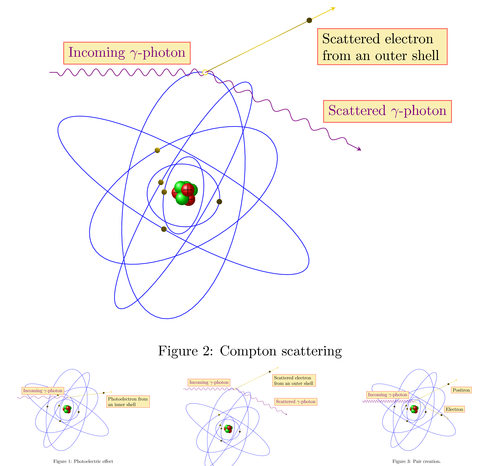An illustration of the different ways gamma radiation interacts with matter.
Notice the smart use of snakes with different segment length values to illustrate change of wavelengths.
Author: Poul Riis
Edit and compile if you like:
\documentclass[a4paper,10pt]{article}
\usepackage[usenames,dvipsnames,x11names]{xcolor}
\usepackage{tikz}
\usetikzlibrary{arrows,snakes,shapes}
%\proton{xposition,yposition}
\newcommand{\proton}[1]{%
\shade[ball color=red] (#1) circle (.25);\draw (#1) node{$+$};
}
%\neutron{xposition,yposition}
\newcommand{\neutron}[1]{%
\shade[ball color=green] (#1) circle (.25);
}
%\electron{xwidth,ywidth,rotation angle}
\newcommand{\electron}[3]{%
\draw[rotate = #3](0,0) ellipse (#1 and #2)[color=blue];
\shade[ball color=Gold2] (0,#2)[rotate=#3] circle (.1);
}
\newcommand{\nucleus}{%
\neutron{0.1,0.3}
\proton{0,0}
\neutron{0.3,0.2}
\proton{-0.2,0.1}
\neutron{-0.1,0.3}
\proton{0.2,-0.15}
\neutron{-0.05,-0.12}
\proton{0.17,0.21}
}
%\photoelectron{xwidth,ywidth,rotation angle}
\newcommand{\photoelectron}[3]{%
\draw[rotate = #3](0,0) ellipse (#1 and #2)[color=blue];%
\draw[snake=coil,%
line after snake=0pt, segment aspect=0,%
segment length=20pt,color=red!50!blue](#3:#1)-- +(-6,0)%
node[fill=white!70!Gold2,draw=red!80!white, above=0.2cm,pos=0.5]%
{Incoming $\gamma$-photon};%
\draw[-stealth,Gold2](#3:#1) -- ++ (5,0.625);%
\shade[ball color=Gold2](#3:#1) -- ++(4,0.5)%
node[fill=white!70!Gold2,draw=red!80!white,%
text width=3cm, below right=0.2cm]%
{Photoelectron from an inner shell} circle(0.1);%
\fill (#1,0)[rotate=#3,color=white,opaque] circle (.1);%
\draw (#1,0)[rotate=#3,color=Gold2] circle (.1) ;%
}
%\comptonelectron{xwidth,ywidth,rotation angle}
\newcommand{\comptonelectron}[3]{%
\draw[rotate = #3](0,0) ellipse (#1 and #2)[color=blue];%
\draw[snake=coil, line after snake=0pt,%
segment aspect=0, segment length=10pt,color=red!50!blue]%
(#3:#1)-- +(-6,0)%
node[fill=white!70!Gold2,draw=red!80!white, above=0.2cm,pos=0.5]%
{Incoming $\gamma$-photon};%
\draw[-stealth,Gold2](#3:#1) -- ++ (5,2.5);%
\shade[ball color=Gold2](#3:#1) -- ++(4,2.0)%
node[fill=white!70!Gold2,draw=red!80!white, text width=3cm,%
below right=0.2cm]{Scattered electron from an outer shell} circle(0.1);%
\fill (#1,0)[rotate=#3,color=white,opaque] circle (.1);%
\draw (#1,0)[rotate=#3,color=Gold2] circle (.1) ;%
\draw[snake=coil, line after snake=1mm, segment aspect=0,%
segment length=15pt,color=red!50!blue,-stealth] (#3:#1)-- ++(6,-3)%
node[fill=white!70!Gold2,draw=red!80!white, right=1cm,pos=0.5]%
{Scattered $\gamma$-photon};%
}
%\paircreation{impact parameter}
\newcommand{\paircreation}[1]{%
\draw[snake=coil, line after snake=0pt, segment aspect=0,%
segment length=5pt,color=red!50!blue] (0,#1)-- +(-6,0)%
node[fill=white!70!Gold2,draw=red!80!white, above=0.2cm,pos=0.5]%
{Incoming $\gamma$-photon};%
\draw[-stealth,Gold2](0,#1) -- ++ (5,2.5);%
\shade[ball color=Gold2](0,#1) -- ++(4,2.0)%
node[fill=white!70!Gold2,draw=red!80!white, below right=0.2cm]%
{Positron} circle(0.1);%
\draw[-stealth,Gold2](0,#1) -- ++ (4,-2.0);%
\shade[ball color=Gold2](0,#1) -- ++(3.2,-1.6)%
node[fill=white!70!Gold2!,draw=red!80!white, above right=0.2cm]%
{Electron} circle(0.1);%
}
%
\begin{document}
\pagestyle{empty}
\begin{figure}
\centering
\begin{tikzpicture}[scale=0.65]
\nucleus
\electron{1.2}{1.4}{260}
\electron{4}{2}{30}
\electron{5}{1}{60}
\electron{5.5}{1.5}{150}
\electron{4.8}{2.25}{80}
\photoelectron{1.5}{0.75}{80}
\end{tikzpicture}
\caption{Photoelectric effect}
\end{figure}
\begin{figure}
\centering
\begin{tikzpicture}[scale=0.65]
\nucleus
\electron{1.5}{0.75}{80}
\electron{1.2}{1.4}{260}
\electron{4}{2}{30}
\electron{5}{1}{60}
\electron{5.5}{1.5}{150}
\comptonelectron{4.8}{2.25}{80}
\end{tikzpicture}
\caption{Compton scattering}
\end{figure}
\begin{figure}
\centering
\begin{tikzpicture}[scale=0.65]
\nucleus
\electron{1.5}{0.75}{80}
\electron{1.2}{1.4}{260}
\electron{4}{2}{30}
\electron{5}{1}{60}
\electron{5.5}{1.5}{150}
\electron{4.8}{2.25}{80}
\paircreation{1}
\end{tikzpicture}
\caption{Pair creation.}
\end{figure}
\end{document}
Click to download: gamma-interaction.tex • gamma-interaction.pdf
Open in Overleaf: gamma-interaction.tex


